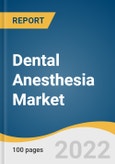The global dental anesthesia market size is expected to reach USD 2.81 billion by 2030., registering a CAGR of 5.2% from 2023 to 2030. Dental anesthesia administration is a standard procedure used to numb the mouth and help you relax during oral and maxillofacial surgery or procedure. It consists of local anesthetics, general anesthesia, and sedation. In dentistry, the most commonly used local anesthetic is lidocaine.
The rising demand for dental checkups and the increased prevalence of dental problems are two factors that are primarily driving the growth of the dental anesthesia market. One of the most frequent chronic disorders in both children and adults is dental caries, sometimes known as tooth decay. Additionally, during the forecast period, it is predicted that rising technological advancements and growing awareness about oral health in emerging regions will propel the market for dental anesthesia market.
According to the National Institute of Dental Research, tooth decay is the most prevalent dental condition in both children and adults. Also, dental caries affects over 92% of people between the age of 20 and 64. Bad lifestyle habits and poor diet, especially amongst teenagers which leads to tooth decay is rising are also contributing to the market growth. With the rising number of dental cases, the demand for treatment and procedures rises. The CDC reported that in 2019, 86.9% of children between the ages of 2 and 17 were reported to have visited a dentist in the United States. Additionally, as disposable incomes in emerging economies have increased, the population's willingness to pay for pricey aesthetic dental operations, particularly among the aging population is also rising.
The market for dental anesthesia has been severely impacted by the COVID-19 outbreak. Many dental treatments and operations were initially put on hold as a result of the lockdown and international limitations that were implemented in the majority of the countries. Initially, the outbreak resulted in a decrease in the number of dental procedures performed each year, resulting in an overall decline in the market. According to a survey in July 2020 by North American Dental Group, 71% of patients said they were reluctant to go to the dentist for a routine dental operation during the pandemic. Furthermore, the COVID-19 pandemic has caused a huge disruption in the supply chain of the overall medical industry.
The rising demand for dental checkups and the increased prevalence of dental problems are two factors that are primarily driving the growth of the dental anesthesia market. One of the most frequent chronic disorders in both children and adults is dental caries, sometimes known as tooth decay. Additionally, during the forecast period, it is predicted that rising technological advancements and growing awareness about oral health in emerging regions will propel the market for dental anesthesia market.
According to the National Institute of Dental Research, tooth decay is the most prevalent dental condition in both children and adults. Also, dental caries affects over 92% of people between the age of 20 and 64. Bad lifestyle habits and poor diet, especially amongst teenagers which leads to tooth decay is rising are also contributing to the market growth. With the rising number of dental cases, the demand for treatment and procedures rises. The CDC reported that in 2019, 86.9% of children between the ages of 2 and 17 were reported to have visited a dentist in the United States. Additionally, as disposable incomes in emerging economies have increased, the population's willingness to pay for pricey aesthetic dental operations, particularly among the aging population is also rising.
The market for dental anesthesia has been severely impacted by the COVID-19 outbreak. Many dental treatments and operations were initially put on hold as a result of the lockdown and international limitations that were implemented in the majority of the countries. Initially, the outbreak resulted in a decrease in the number of dental procedures performed each year, resulting in an overall decline in the market. According to a survey in July 2020 by North American Dental Group, 71% of patients said they were reluctant to go to the dentist for a routine dental operation during the pandemic. Furthermore, the COVID-19 pandemic has caused a huge disruption in the supply chain of the overall medical industry.
Dental Anesthesia Market Report Highlights
- The local segment dominated the dental anesthesia market with a market share of 52.9% in 2022. Local anesthesia is the most common type of anesthesia used during dental procedures. Local anesthetics work by preventing the nerves in the affected area from communicating sensations of pain to the brain
- Asia Pacific dominated the global market in 2022 with a market share of 38.6%, owing to the rising technological advancements for dental treatment and an increasing number of specialist dental service providers. The rising prevalence of edentulism in developing countries such as India and China will drive the Asia Pacific market growth. Edentulism is a major contributor to the disease burden for oral health. Furthermore, Asia Pacific is expected to reciprocate the highest CAGR over the forecast period owing to the growing patient population and rising awareness
- The dental clinics segment is dominating the market in the end-use segment due to the rising number of clinics and dentists in the world
Table of Contents
Chapter 1 Methodology and Scope
Chapter 2 Executive Summary
Chapter 3 Dental Anesthesia Market: Variables, Trends, & Scope
Chapter 4 Dental Anesthesia Market: Type Segment Analysis
Chapter 5 Dental Anesthesia Market: End-use Segment Analysis
Chapter 6 Dental Anesthesia Market: Regional Analysis
Chapter 7 Company Profiles
List of Tables
List of Figures
Companies Mentioned
- Laboratorios Inibsa
- Dentsply Sirona
- Pierre Pharma
- Septodont
- Laboratorios Normon
- Dentalhitec
- Primex Pharmaceuticals
- Aspen Group
- Zeyco
Methodology

LOADING...








